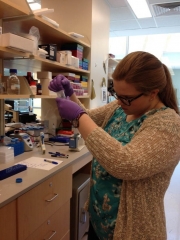Posted on August 26, 2014
Source: Emily Toler, Baltimore HIV Scholar

This summer I am working with Laura Ensign, Ph.D. at the Hanes Lab. The lab is part of the Center for Nanomedicine at the Johns Hopkins School of Medicine. Dr. Ensign has been studying the role that the mucus barrier in the cervicovaginal tract plays in susceptibility to infections such as HIV. We are taking particular interest in how a condition called Bacterial Vaginosis (BV) impacts susceptibility. BV is characterized by a lack of the normally dominant vaginal bacteria. It impacts one-third of women and is known to increase susceptibility to sexually transmitted infections.
A lot of what I did this week involved collecting mucus samples from donors and processing and analyzing the samples. When we obtain a mucus sample from a donor, we use the centrifuge to spin the sample down. This allows us to see if there is enough mucus for us to use and helps us to visually inspect the sample. We make note of the color and consistency of the sample and test its stretchiness to make sure the sample is not ovulatory. This is very important, as ovulatory mucus has very different properties from non-ovulatory mucus. We also test each donor’s urine for ovulation and pregnancy hormones.
Next, we perform three tests in order to determine if the sample is normal or indicative of BV. First we read the pH of each sample. A pH of 4.5 or less is considered normal, while a pH above 4.5 is typical of BV. The acidic environment of the vagina plays an important role in protection from infection. Then we perform the whiff test. A BV sample, when combined with potassium hydroxide, gives off a strong fishy odor. A normal sample has no fishy odor. The final test we run involves looking at the mucus under the microscope. We look for the presence or lack of the right type of bacteria and for “clue cells,” vaginal epithelial cells coated in bacteria that are indicative of BV.
After classifying a sample as a normal or a BV sample, we add fluorescently labeled HIV or polystyrene particles to the mucus and look at the movement of them. If the particles don’t seem to be moving this means the mucus traps them and has the potential to prevent infection. If the particles appear very diffusive and move around a lot, this means the sample does not trap them well. A person whose mucus does not trap well is more susceptible to infection because the virus has a better chance of reaching cells. We take movies of the particles moving in the mucus and then analyze the movies using a MATLAB-based automated particle tracking code. There is then further processing using Microsoft Excel.
I am really enjoying the experience so far and am looking forward to learning more about this research. I have loved working with Dr. Ensign and several of the graduate students in the lab. In the coming weeks I will be doing a lot of data analysis and will hopefully reach some conclusions. I will specifically be looking at data on mucus collected from asymptomatic and symptomatic BV donors, and will be comparing that data to historical data on normal mucus. I hope to continue doing research in this lab in the fall.